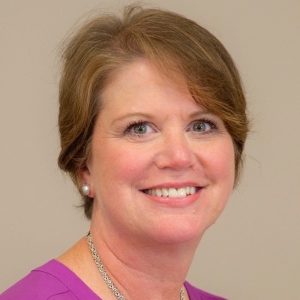Interview With Dr. Carol Dudding of James Madison University

Carol C. Dudding, PhD CCC-SLP CHSE is an associate professor and director of the online masters degree program at James Madison University in Harrisonburg, VA. She is a Distinguished Scholar in the National Academies of Practice in recognition of her work in interprofessional education. Carol is a nationally Certified Healthcare Simulation Educator (CHSE) from the Society for Simulation in Healthcare. Her research interests include the use of technology for clinical education. Her current work is in the area of virtual simulations.
Note: You should consult with your doctor or speech pathologist for recommendations on treatment. The views and opinions expressed in this article are those of Dr. Dudding and do not necessarily reflect the official policy or position of SpeechPathologyMastersPrograms.com
How did you become interested in researching using virtual simulations for clinical education?
I have a long-standing interest in the use of technology for clinical education. Earlier in my career, I did research in the areas of telesupervision and telepractice. I have always been envious of the simulation labs found in larger nursing and medical programs. I thought simulation experiences would be a great way to offer our students training in a safe environment. And yet, these simulations labs come with a high price tag. The manikins alone can cost more than $100,000, not to mention the space and personnel needs. I considered the use of standardized patients (actors) but that form of simulation also comes with a cost and requires special training. For most speech-language pathology programs, a simulation lab is just not feasible. Along with advancements in mobile technology, specifically virtual reality, the possibility of creating simulations for our own clinical training needs seemed feasible.
What are some examples of virtual simulations you would use to educate a graduate speech pathology student online?
We have been using a commercially available product known as Simucase for our online students. Simucase uses videos and avatars in an interactive, computer-based environment to give students a range of experiences in diagnostics and treatment methods. We have employed Simucase as part of our clinical course offered to online students prior to their first practicum experience. We found that this approach not only provides them with clinical skill practice but gives them confidence for when they work with a live client. Some faculty use these simulations as part of the academic coursework, especially in the disorders courses. Another way in that we use simulations, is as a form of remediation for those students who need more assistance in obtaining certain clinical skills.
What have you learned about the effectiveness of these simulations?
Simulations, both within speech-language pathology and other medical training programs, have been shown to be effective as a clinical training tool. In 2014, the Journal of Nursing Regulation published the results of a landmark study investigating the use of simulations in nursing education (Hayden, Smiley, Alexander, Kardong-Edgren, & Jeffries, 2014). This study examined the outcomes of 660 nursing students from 10 programs. The students were randomly assigned to one of three groups: one group received all clinical education with live patients, a second treatment group replaced 25% of clinical education with simulation and a third group that replaced 50% of clinical education with simulation. Findings showed that there were no significant differences between the groups in terms of clinical competency, critical thinking, and preparedness to practice as a registered nurse (RN). Cook and colleagues (2011) conducted a meta-analysis examining the effectiveness of simulations for student training. The researchers concluded that “…technology-enhanced simulation training in health professions education is consistently associated with large effects for outcomes of knowledge, skills, and behaviors and moderate effects for patient-related outcomes” (Cook et al., 2011, p. 978). These results support the use simulations as a viable supplement to traditional practice with real patients.
How can virtual simulation improve interprofessional collaboration? Why is this important?
I was part of a three year interprofessional grant program here at JMU. We used a combination of instructional methods, including face-to-face workshops, online coursework, standard patients, and virtual patients to offer students practice in interprofessional collaboration. We found that the hands-on opportunities to work collaboratively were the most effective ways to reinforce the competencies of teamwork and communication. We all learned, the faculty and students, that collaborative practice is challenging. Schedules, time restrictions, and lack of knowledge of other disciplines makes the process complex. The use of simulations allowed students to explore their roles and learn about others in a safe environment where they could practice and improve their interprofessional skills.
What aspect of your research are you most proud of?
I have been fortunate to collaborate with doctoral students on several projects. I am very proud of my work with Dr. Beth Nottingham. Together we conducted a national survey of Communication Science and Disorders programs across the U.S. to determine practices and attitudes towards simulation. I believe the information helped to foster a dialogue within our profession about the benefits of simulations for clinical education. In fact, just prior to publication of the results (Dudding & Nottingham, 2018), the CFCC of the American Speech-Language Hearing Association changed the language within the standards to allow for simulation to count towards a portion of required clinical clock hours. The article offers a review of the research in speech language pathology for those interested.
What is it like teaching speech pathology courses online? What are the benefits and challenges?
We are fortunate that our online masters degree program has been in existence since 2007 so we have had lots of opportunity to develop our online teaching. Our instructors are doctoral level faculty with extensive experience in teaching in both face to face and online formats. They have spent many hours in improving teaching methods and keeping up with the latest technologies. With that said, there are challenges and benefits for both faculty and students. Online courses offer benefits in flexibility of scheduling. Students don’t have to travel to attend class. Many of our courses are asynchronous, so students can complete much of the work at a time that fits their schedule. Typically, online courses offer varied ways for students to engage with the content. This would include recorded lectures, discussion forums, group presentations, and as mentioned earlier, simulations. The challenges of online courses, especially as part of a rigorous masters degree program, are that success requires individual commitment, discipline and sacrifice. It is often the case that online learners have very busy and demanding personal lives, (children, full-time jobs, family caregiver, etc). These responsibilities don’t lessen because someone is in an online program. In our program, students often have to adjust their work schedules to participate in clinical practica. We have found the biggest challenge of online learning is managing all aspects of life with the many demands of a masters degree program in speech-language pathology.
What is your advice to online graduate speech pathology students?
I have a few pieces of advice…The first is to realize this is a marathon and not a sprint. You will experience both highs and lows and just need to keep your eye on the finish line. That leads to my next piece of advice, seek out and accept support from all sources. If a neighbor offers to watch your children during your exam, accept the offer knowing that you will have opportunity to return the favor one day.
Sponsored online speech pathology programs

Online MS: Pursue SLP Certification. Study FT/PT
Speech@Emerson enables you to earn an MS online and pursue SLP certification in as few as 20 mos. Learn the same curriculum as the on-campus program. Study FT or PT.
- Prepares you to pursue certification as an SLP generalist
- In-person clinical placements at faculty-approved partner sites
- As few as 20 months to complete
SPONSORED

Want to Become an SLP? Earn an MS Online at NYU
NYU Steinhardt’s online master of science program in Communicative Sciences and Disorders prepares aspiring speech-language pathologists with a comprehensive professional education.
- Prepares students to pursue SLP licensure
- Accredited by ASHA’s Council on Academic Accreditation
- As few as six terms to complete
- Full-time and part-time plans of study
SPONSORED
References
Cook, D. A., Hatala, R., Brydges, R., Szostek, J. H., Wang, A. T.,
Erwin, P. J., & Hamstra, S. J. (2011). Technology-enhanced simulation for health professions education: A systematic review and meta-analysis. Journal of
the American Medical Association, 306(9), 978 – 988.
Dudding, C.C. & Nottingham, E.E. (2018). A national survey of simulation use in university programs in communication sciences and disorders, American Journal of Speech- Language Pathology, 27 (71-81). https://doi.org/10.1044/2017_AJSLP-17-0015
Hayden, J. K., Smiley, R. A., Alexander, M., Kardong-Edgren, S.,
& Jeffries, P. R. (2014). The NCSBSN national simulation
study: A longitudinal, randomized, controlled study replacing
clinical hours with simulation in prelicensure nursing education.
Journal of Nursing Regulation, 5(2), S4 – S41.

